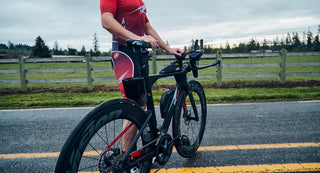Triathlon can feel like it's full of rules. There are water temperature cutoffs for wetsuits, drafting rules that can change based on federation and race group, and tiny details that can make a big difference if it means the end of your race. We break down some of the most important rules to know before race day:
Drafting
If you're racing a non-draft legal race, this is one of the most important rules to understand. And like we mentioned before, the rule can actually change depending on where you're racing. Note: the information in this post are accurate as of July 22, 2024. These rules may be updated, so we encourage you to review your local drafting rules to ensure they are the most up-to-date.
Here are a few:
- In 2023, USA Triathlon increased their draft zones to follow World Triathlon from "7 meters to 10 meters for Sprint and Standard (Olympic) distance races and 12 meters for distances longer than Standard." Failure to follow this draft zone will result in a time penalty ranging from 1-5 minutes (depending on the race distance) and will be served at a designated area versus being added on to final time.
- For IRONMAN events and Challenge events (for age groupers!), the draft zone is 12 meters with a 25-second pass time. If you break this rule, you will receive a 5-minute time penalty to be served at a penalty tent.
Note: drafting and passing doesn't just apply to the passing athlete -- if you are being passed, you cannot surge forward to prevent a pass or immediately re-pass before dropping out of the draft zone, or you risk getting your own (shorter) time penalty.

Blocking
This is actually one of the rules that we hear the most questions about from new triathletes. Think: have you ever been riding down the road and another athlete passing has yelled for you to move over? There's a good chance you were "blocking." This means that you're not riding over to the side of the road (the right in the US) and are preventing others from safely passing.
In short: if you could ride side-by-side with another athlete, you need to move into a single-file line. Failure to follow this rule could result in a varying time penalty depending on the race organization and distance.
Helmets
Helmets? Yeah, we all know we need to wear helmets. But did you know that your helmet needs to be on your head and buckled if you're riding your bike -- at ALL times on race day (and at the race course)? I personally watched a friend get DQ'd after winning a race because he swung his leg over his bike out of transition and THEN buckled his helmet. No, my friend is not Sam Long, but as you can see from this T100 video, the pros have made this mistake too. In this case, it resulted in a 30 second penalty.

Race organizers don't mess around with safety. In T1, helmet goes on and is buckled first.
And remember that note above about this rule applying to race day -- not just during the race? Yes, that's right. If you're on the bike doing things like course familiarization or training, your helmet should be on and fastened. Don't risk a DQ before you've even started the race -- this was something my collegiate coach drilled into our heads as soon as my team arrived at the race site.
As USAT mentions in their rules: "Helmets must be used in all official activities when the athlete rides the bike: competition, familiarization, and training sessions."
Headphones
We'll keep this one short and sweet -- don't use them; they're against the race rules. If you're worried about running without headphones, start training to do your runs listening to the sweet sounds of your own breathing.
Littering
Again, another one that feels self-explanatory. Don't leave trash on the course. We're guests at race locations -- and on this earth in general -- so take care of it. So why is this on our list then? Because there are a few details we think everyone should know about what "litter" is and where you CAN leave trash.
- You CAN toss trash (food wrappers, clothing, bottles, etc.) at designated aid stations. The race organizers will let you know in the athlete guide or race briefings how long this zone is, but as a rule of thumb, leave trash after the first trash can and before the last trash can. Outside of that zone, you risk a time penalty and the volunteers really won't love you. Remember, they're picking up after you (thank you volunteers!)...don't be rude.
- Did you know that anything falling off of your bike outside of this aid station zone counts as littering? This means water bottles too. Pros such as Paula Findlay (while speaking on the That Triathlon Life Podcast) have spoken about the times they've hit potholes or train tracks and had bottles launch off of their frames and have turned around to pick them back up again to avoid a time penalty. Pros - they're just like us!

There are many other rules that first-time racers should know before racing including what mount and dismount lines are, wearing race numbers and outside assistance (aka there's ZERO outside assistance). Before every race, it's a smart idea for you to review that race's rules and athlete guide as they can change from race to race and year to year.
Check out Challenge/World Triathlon's Rulebook
Our racing time is too short to risk a preventable DQ.
Written by Megan Tuncer


